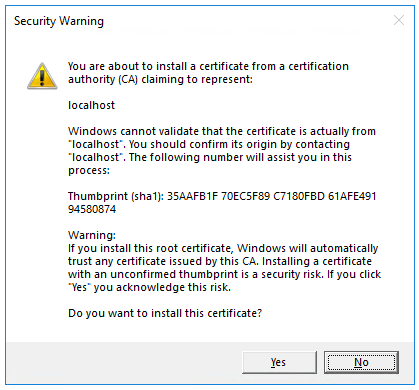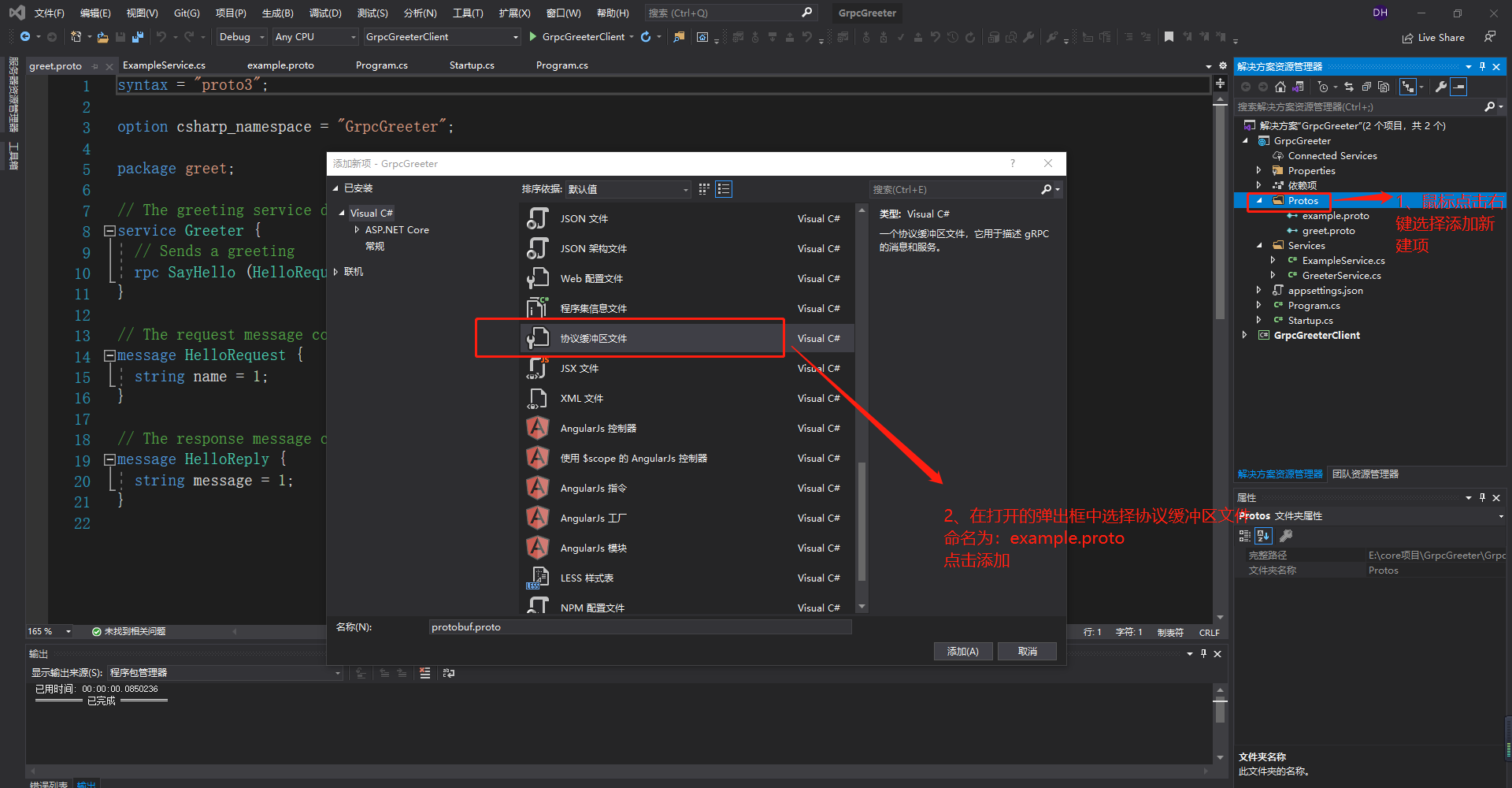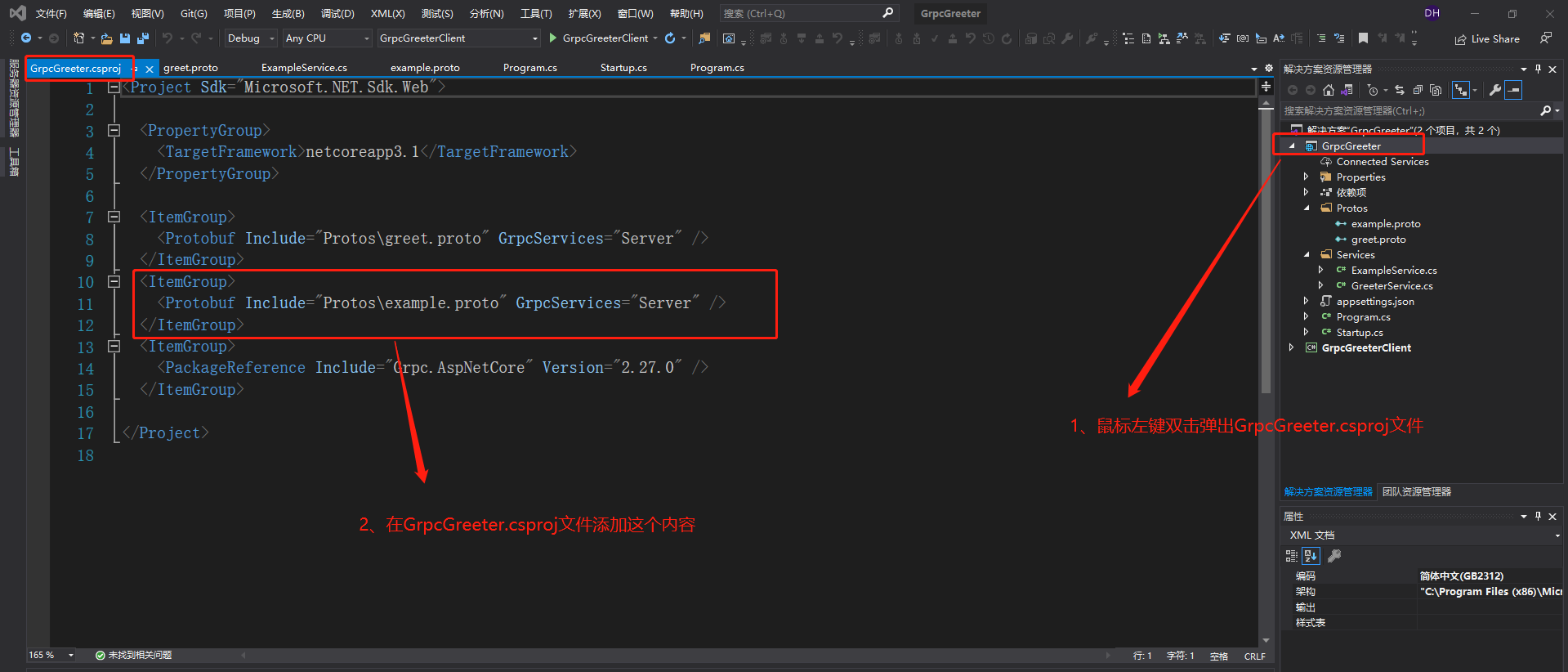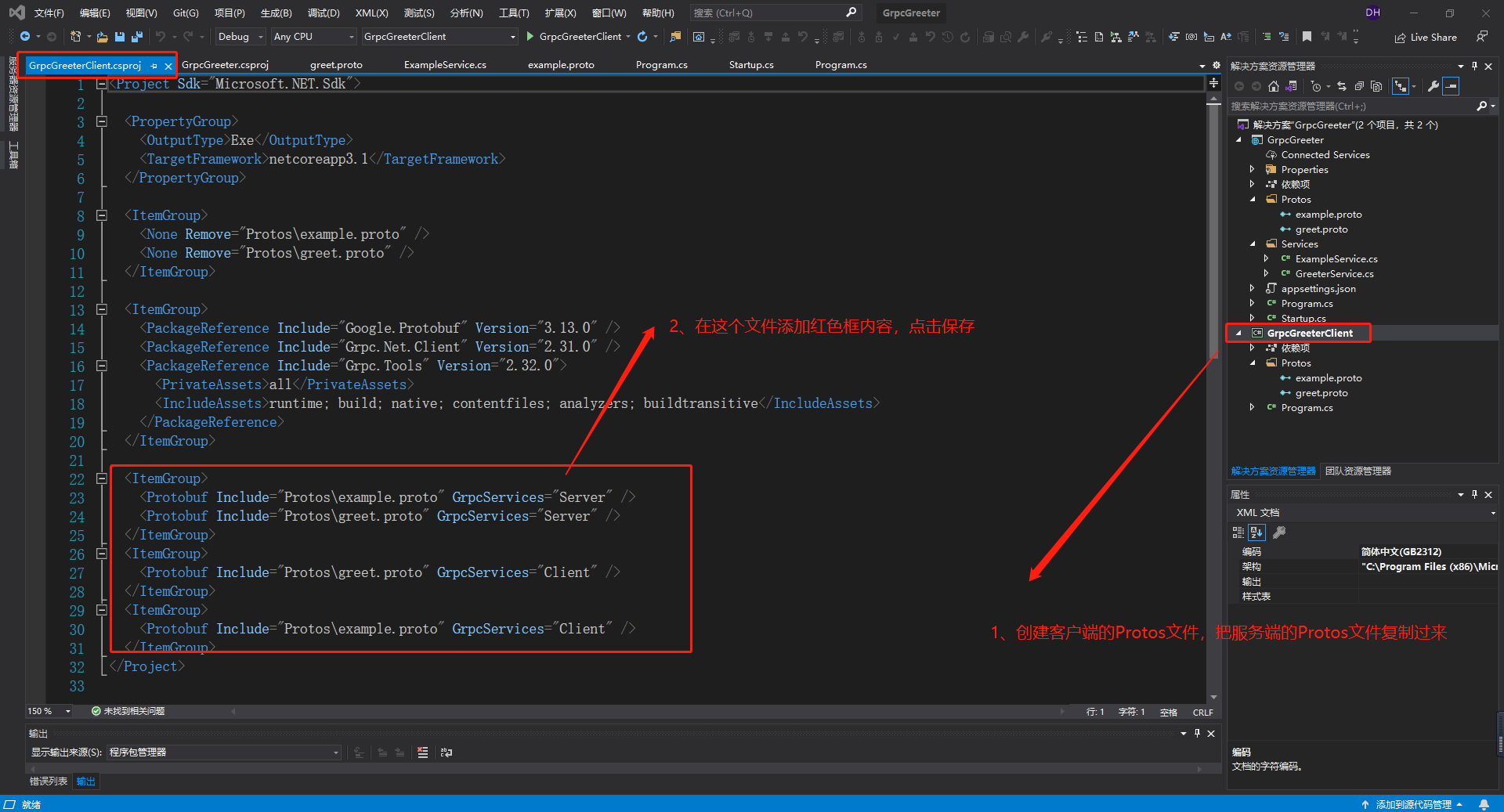主要参考文章微软官方文档: https://docs.microsoft.com/zh-cn/aspnet/core/grpc/client?view=aspnetcore-3.1
此外还参考了文章 https://www.cnblogs.com/stulzq/p/11581967.html并写了一个demo: https://files.cnblogs.com/files/hudean/GrpcDemo.zip
damo github地址: https://github.com/hudean/GrpcDemo
一、简介
gRPC 是一种与语言无关的高性能远程过程调用 (RPC) 框架。
gRPC 的主要优点是:
- 现代高性能轻量级 RPC 框架。
- 协定优先 API 开发,默认使用协议缓冲区,允许与语言无关的实现。
- 可用于多种语言的工具,以生成强类型服务器和客户端。
- 支持客户端、服务器和双向流式处理调用。
- 使用 Protobuf 二进制序列化减少对网络的使用。
这些优点使 gRPC 适用于:
- 效率至关重要的轻量级微服务。
- 需要多种语言用于开发的 Polyglot 系统。
- 需要处理流式处理请求或响应的点对点实时服务。
二、创建 gRPC 服务
-
启动 Visual Studio 并选择“创建新项目”。 或者,从 Visual Studio“文件”菜单中选择“新建” > “项目” 。
-
在“创建新项目”对话框中,选择“gRPC 服务”,然后选择“下一步” :

-
将项目命名为 GrpcGreeter。 将项目命名为“GrpcGreeter”非常重要,这样在复制和粘贴代码时命名空间就会匹配。
-
选择“创建”。
-
在“创建新 gRPC 服务”对话框中:
- 选择“gRPC 服务”模板。
- 选择“创建”。
运行服务
-
按 Ctrl+F5 以在不使用调试程序的情况下运行。
Visual Studio 会显示以下对话框:

如果信任 IIS Express SSL 证书,请选择“是” 。
将显示以下对话框:

如果你同意信任开发证书,请选择“是”。
日志显示该服务正在侦听 https://localhost:5001。
控制台显示如下:
info: Microsoft.Hosting.Lifetime[0]
Now listening on: https://localhost:5001
info: Microsoft.Hosting.Lifetime[0]
Application started. Press Ctrl+C to shut down.
info: Microsoft.Hosting.Lifetime[0]
Hosting environment: Development
备注
gRPC 模板配置为使用传输层安全性 (TLS)。 gRPC 客户端需要使用 HTTPS 调用服务器。
macOS 不支持 ASP.NET Core gRPC 及 TLS。 在 macOS 上成功运行 gRPC 服务需要其他配置。
检查项目文件
GrpcGreeter 项目文件:
- greet.proto : Protos/greet.proto 文件定义
GreetergRPC,且用于生成 gRPC 服务器资产。 - Services 文件夹:包含
Greeter服务的实现。 - appSettings.json :包含配置数据,例如 Kestrel 使用的协议。
- Program.cs:包含 gRPC 服务的入口点。
Startup.cs :包含配置应用行为的代码。
上述准备工作完成,开始写gRPC服务端代码!

example.proto文件内容如下

syntax = "proto3"; option csharp_namespace = "GrpcGreeter"; package example; service exampler { // Unarys rpc UnaryCall (ExampleRequest) returns (ExampleResponse); // Server streaming rpc StreamingFromServer (ExampleRequest) returns (stream ExampleResponse); // Client streaming rpc StreamingFromClient (stream ExampleRequest) returns (ExampleResponse); // Bi-directional streaming rpc StreamingBothWays (stream ExampleRequest) returns (stream ExampleResponse); } message ExampleRequest { int32 id = 1; string name = 2; } message ExampleResponse { string msg = 1; }
其中:
syntax = "proto3";是使用 proto3 语法,protocol buffer 编译器默认使用的是 proto2 。 这必须是文件的非空、非注释的第一行。
对于 C#语言,编译器会为每一个.proto 文件创建一个.cs 文件,为每一个消息类型都创建一个类来操作。
option csharp_namespace = "GrpcGreeter";是c#代码的命名空间
package example;包的命名空间
service exampler 是服务的名字
rpc UnaryCall (ExampleRequest) returns (ExampleResponse); 意思是rpc调用方法 UnaryCall 方法参数是ExampleRequest类型 返回值是ExampleResponse 类型
message ExampleRequest {
int32 id = 1;
string name = 2;
}
指定字段类型
在上面的例子中,所有字段都是标量类型:一个整型(id),一个string类型(name)。当然,你也可以为字段指定其他的合成类型,包括枚举(enumerations)或其他消息类型。
分配标识号
我们可以看到在上面定义的消息中,给每个字段都定义了唯一的数字值。这些数字是用来在消息的二进制格式中识别各个字段的,一旦开始使用就不能够再改变。注:[1,15]之内的标识号在编码的时候会占用一个字节。[16,2047]之内的标识号则占用2个字节。所以应该为那些频繁出现的消息元素保留
[1,15]之内的标识号。切记:要为将来有可能添加的、频繁出现的标识号预留一些标识号。
最小的标识号可以从1开始,最大到2^29 - 1, or 536,870,911。不可以使用其中的[19000-19999]的标识号, Protobuf协议实现中对这些进行了预留。如果非要在.proto文件中使用这些预留标识号,编译时就会报警。类似地,你不能使用之前保留的任何标识符。
指定字段规则
消息的字段可以是一下情况之一:
singular(默认):一个格式良好的消息可以包含该段可以出现 0 或 1 次(不能大于 1 次)。
repeated:在一个格式良好的消息中,这种字段可以重复任意多次(包括0次)。重复的值的顺序会被保留。
默认情况下,标量数值类型的repeated字段使用packed的编码方式。

在GrpcGreeter.csproj文件添加:
<ItemGroup>
<Protobuf Include="Protos\example.proto" GrpcServices="Server" />
</ItemGroup>
点击保存
在Services文件夹下添加ExampleService类,代码如下:

using System; using System.Collections.Generic; using System.Linq; using System.Threading.Tasks; using Grpc.Core; namespace GrpcGreeter { public class ExampleService :exampler.examplerBase { /// <summary> /// 一元方法以参数的形式获取请求消息,并返回响应。 返回响应时,一元调用完成。 /// </summary> /// <param name="request"></param> /// <param name="context"></param> /// <returns></returns> public override Task<ExampleResponse> UnaryCall(ExampleRequest request, ServerCallContext context) { // return base.UnaryCall(request, context); return Task.FromResult(new ExampleResponse { Msg = "id :" + request.Id + "name : " + request.Name + " hello" }) ; } /// <summary> /// 服务器流式处理方法 /// 服务器流式处理方法以参数的形式获取请求消息。 由于可以将多个消息流式传输回调用方,因此可使用 responseStream.WriteAsync 发送响应 /// 消息。 当方法返回时,服务器流式处理调用完成。 /// </summary> /// <param name="request"></param> /// <param name="responseStream"></param> /// <param name="context"></param> /// <returns></returns> public override async Task StreamingFromServer(ExampleRequest request, IServerStreamWriter<ExampleResponse> responseStream, ServerCallContext context) { /** * 服务器流式处理方法启动后,客户端无法发送其他消息或数据。 某些流式处理方法设计为永久运行。 对于连续流式处理方法,客户端可以在*再需要调用时将其取消。 当发生取消时,客户端会将信号发送到服务器,并引发 ServerCallContext.CancellationToken。 应在服务器上通过异步方法使用 CancellationToken 标记,以实现以下目的: 所有异步工作都与流式处理调用一起取消。 该方法快速退出。 **/ //return base.StreamingFromServer(request, responseStream, context); //for (int i = 0; i < 5; i++) //{ // await responseStream.WriteAsync(new ExampleResponse { Msg = "我是服务端流for:" + i }); // await Task.Delay(TimeSpan.FromSeconds(1)); //} int index = 0; while (!context.CancellationToken.IsCancellationRequested) { index++; await responseStream.WriteAsync(new ExampleResponse { Msg = "我是服务端流while" + index+" "+request.Id+" "+request.Name }); await Task.Delay(TimeSpan.FromSeconds(1), context.CancellationToken); } } /// <summary> /// 客户端流式处理方法 /// 客户端流式处理方法在该方法没有接收消息的情况下启动。 requestStream 参数用于从客户端读取消息。 返回响应消息时,客户端流式处理调用 /// 完成: /// </summary> /// <param name="requestStream"></param> /// <param name="context"></param> /// <returns></returns> public override async Task<ExampleResponse> StreamingFromClient(IAsyncStreamReader<ExampleRequest> requestStream, ServerCallContext context) { // return base.StreamingFromClient(requestStream, context); List<string> list = new List<string>(); while (await requestStream.MoveNext()) { //var message = requestStream.Current; var id = requestStream.Current.Id; var name = requestStream.Current.Name; list.Add($"{id}-{name}"); // ... } return new ExampleResponse() { Msg = "我是客户端流while"+string.Join(',',list) }; //await foreach (var message in requestStream.ReadAllAsync()) //{ // // ... //} // return new ExampleResponse() { Msg= "我是客户端流foreach" }; } /// <summary> /// 双向流式处理方法 /// 双向流式处理方法在该方法没有接收到消息的情况下启动。 requestStream 参数用于从客户端读取消息。 /// 该方法可选择使用 responseStream.WriteAsync 发送消息。 当方法返回时,双向流式处理调用完成: /// </summary> /// <param name="requestStream"></param> /// <param name="responseStream"></param> /// <param name="context"></param> /// <returns></returns> public override async Task StreamingBothWays(IAsyncStreamReader<ExampleRequest> requestStream, IServerStreamWriter<ExampleResponse> responseStream, ServerCallContext context) { //return base.StreamingBothWays(requestStream, responseStream, context); await foreach (var message in requestStream.ReadAllAsync()) { string str= message.Id + " " + message.Name; await responseStream.WriteAsync(new ExampleResponse() { Msg="我是双向流:"+ str }); } //// Read requests in a background task. //var readTask = Task.Run(async () => //{ // await foreach (var message in requestStream.ReadAllAsync()) // { // // Process request. // string str = message.Id + " " + message.Name; // } //}); //// Send responses until the client signals that it is complete. //while (!readTask.IsCompleted) //{ // await responseStream.WriteAsync(new ExampleResponse()); // await Task.Delay(TimeSpan.FromSeconds(1), context.CancellationToken); //} } } }
在Startup类里Configure中加入一个这个 endpoints.MapGrpcService<ExampleService>();

using System; using System.Collections.Generic; using System.Linq; using System.Threading.Tasks; using Microsoft.AspNetCore.Builder; using Microsoft.AspNetCore.Hosting; using Microsoft.AspNetCore.Http; using Microsoft.Extensions.DependencyInjection; using Microsoft.Extensions.Hosting; namespace GrpcGreeter { public class Startup { // This method gets called by the runtime. Use this method to add services to the container. // For more information on how to configure your application, visit https://go.microsoft.com/fwlink/?LinkID=398940 public void ConfigureServices(IServiceCollection services) { services.AddGrpc(); } // This method gets called by the runtime. Use this method to configure the HTTP request pipeline. public void Configure(IApplicationBuilder app, IWebHostEnvironment env) { if (env.IsDevelopment()) { app.UseDeveloperExceptionPage(); } app.UseRouting(); app.UseEndpoints(endpoints => { endpoints.MapGrpcService<GreeterService>(); endpoints.MapGrpcService<ExampleService>(); endpoints.MapGet("/", async context => { await context.Response.WriteAsync("Communication with gRPC endpoints must be made through a gRPC client. To learn how to create a client, visit: https://go.microsoft.com/fwlink/?linkid=2086909"); }); }); } } }
就此 gRPC服务端代码完成了
在 .NET 控制台应用中创建 gRPC 客户端
- 打开 Visual Studio 的第二个实例并选择“创建新项目”。
- 在“创建新项目”对话框中,选择“控制台应用(.NET Core)”,然后选择“下一步” 。
- 在“项目名称”文本框中,输入“GrpcGreeterClient”,然后选择“创建” 。
添加所需的包
gRPC 客户端项目需要以下包:
- Grpc.Net.Client,其中包含 .NET Core 客户端。
- Google.Protobuf 包含适用于 C# 的 Protobuf 消息。
- Grpc.Tools 包含适用于 Protobuf 文件的 C# 工具支持。 运行时不需要工具包,因此依赖项标记为
PrivateAssets="All"。
通过包管理器控制台 (PMC) 或管理 NuGet 包来安装包。
用于安装包的 PMC 选项
-
从 Visual Studio 中,依次选择“工具” > “NuGet 包管理器” > “包管理器控制台”
-
从“包管理器控制台”窗口中,运行
cd GrpcGreeterClient以将目录更改为包含 GrpcGreeterClient.csproj 文件的文件夹。
运行以下命令:
PowerShell
Install-Package Grpc.Net.Client Install-Package Google.Protobuf Install-Package Grpc.Tools
管理 NuGet 包选项以安装包
- 右键单击“解决方案资源管理器” > “管理 NuGet 包”中的项目 。
- 选择“浏览”选项卡。
- 在搜索框中输入 Grpc.Net.Client。
- 从“浏览”选项卡中选择“Grpc.Net.Client”包,然后选择“安装” 。
- 为
Google.Protobuf和Grpc.Tools重复这些步骤。
添加 greet.proto
-
在 gRPC 客户端项目中创建 Protos 文件夹。
-
从 gRPC Greeter 服务将 Protos\greet.proto 文件复制到 gRPC 客户端项目。
-
将
greet.proto文件中的命名空间更新为项目的命名空间:option csharp_namespace = "GrpcGreeterClient"; -
编辑 GrpcGreeterClient.csproj 项目文件:
右键单击项目,并选择“编辑项目文件”。
添加具有引用 greet.proto 文件的 <Protobuf> 元素的项组:
<ItemGroup> <Protobuf Include="Protos\greet.proto" GrpcServices="Client" /> </ItemGroup>
创建 Greeter 客户端
构建客户端项目,以在 GrpcGreeter 命名空间中创建类型。 GrpcGreeter 类型是由生成进程自动生成的。
使用以下代码更新 gRPC 客户端的 Program.cs 文件:
using System;
using System.Net.Http;
using System.Threading.Tasks;
using Grpc.Net.Client;
namespace GrpcGreeterClient
{
class Program
{
static async Task Main(string[] args)
{
// The port number(5001) must match the port of the gRPC server.
using var channel = GrpcChannel.ForAddress("https://localhost:5001");
var client = new Greeter.GreeterClient(channel);
var reply = await client.SayHelloAsync(
new HelloRequest { Name = "GreeterClient" });
Console.WriteLine("Greeting: " + reply.Message);
Console.WriteLine("Press any key to exit...");
Console.ReadKey();
}
}
}

添加内容如下:
<ItemGroup>
<Protobuf Include="Protos\example.proto" GrpcServices="Server" />
<Protobuf Include="Protos\greet.proto" GrpcServices="Server" />
</ItemGroup>
<ItemGroup>
<Protobuf Include="Protos\greet.proto" GrpcServices="Client" />
</ItemGroup>
<ItemGroup>
<Protobuf Include="Protos\example.proto" GrpcServices="Client" />
</ItemGroup>
在gRPC客户端写调用服务端代码,代码如下:

using Grpc.Core; using Grpc.Net.Client; using GrpcGreeter; using System; using System.Threading; using System.Threading.Tasks; namespace GrpcGreeterClient { class Program { //static void Main(string[] args) //{ // Console.WriteLine("Hello World!"); //} //static async Task Main(string[] args) //{ // // The port number(5001) must match the port of the gRPC server. // using var channel = GrpcChannel.ForAddress("https://localhost:5001"); // var client = new Greeter.GreeterClient(channel); // var reply = await client.SayHelloAsync( // new HelloRequest { Name = "GreeterClient" }); // Console.WriteLine("Greeting: " + reply.Message); // Console.WriteLine("Press any key to exit..."); // Console.ReadKey(); //} static async Task Main(string[] args) { // The port number(5001) must match the port of the gRPC server. using var channel = GrpcChannel.ForAddress("https://localhost:5001"); var client = new exampler.examplerClient(channel); #region 一元调用 //var reply = await client.UnaryCallAsync(new ExampleRequest { Id = 1, Name = "hda" }); //Console.WriteLine("Greeting: " + reply.Msg); #endregion 一元调用 #region 服务器流式处理调用 //using var call = client.StreamingFromServer(new ExampleRequest { Id = 1, Name = "hda" }); //while (await call.ResponseStream.MoveNext(CancellationToken.None)) //{ // Console.WriteLine("Greeting: " + call.ResponseStream.Current.Msg); //} //如果使用 C# 8 或更高版本,则可使用 await foreach 语法来读取消息。 IAsyncStreamReader<T>.ReadAllAsync() 扩展方法读取响应数据流中的所有消息: //await foreach (var response in call.ResponseStream.ReadAllAsync()) //{ // Console.WriteLine("Greeting: " + response.Msg); // // "Greeting: Hello World" is written multiple times //} #endregion 服务器流式处理调用 #region 客户端流式处理调用 //using var call = client.StreamingFromClient(); //for (int i = 0; i < 5; i++) //{ // await call.RequestStream.WriteAsync(new ExampleRequest { Id = i, Name = "hda" + i }); //} //await call.RequestStream.CompleteAsync(); //var response = await call; //Console.WriteLine($"Count: {response.Msg}"); #endregion 客户端流式处理调用 #region 双向流式处理调用 //通过调用 EchoClient.Echo 启动新的双向流式调用。 //使用 ResponseStream.ReadAllAsync() 创建用于从服务中读取消息的后台任务。 //使用 RequestStream.WriteAsync 将消息发送到服务器。 //使用 RequestStream.CompleteAsync() 通知服务器它已发送消息。 //等待直到后台任务已读取所有传入消息。 //双向流式处理调用期间,客户端和服务可在任何时间互相发送消息。 与双向调用交互的最佳客户端逻辑因服务逻辑而异。 using var call = client.StreamingBothWays(); Console.WriteLine("Starting background task to receive messages"); var readTask = Task.Run(async () => { await foreach (var response in call.ResponseStream.ReadAllAsync()) { Console.WriteLine(response.Msg); // Echo messages sent to the service } }); Console.WriteLine("Starting to send messages"); Console.WriteLine("Type a message to echo then press enter."); while (true) { var result = Console.ReadLine(); if (string.IsNullOrEmpty(result)) { break; } await call.RequestStream.WriteAsync(new ExampleRequest { Id=1,Name= result }); } Console.WriteLine("Disconnecting"); await call.RequestStream.CompleteAsync(); await readTask; #endregion 双向流式处理调用 Console.WriteLine("Press any key to exit..."); Console.ReadKey(); } } }
代码链接地址: https://files.cnblogs.com/files/hudean/GrpcGreeter.zip




